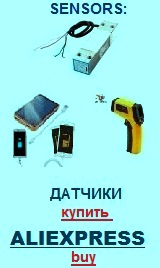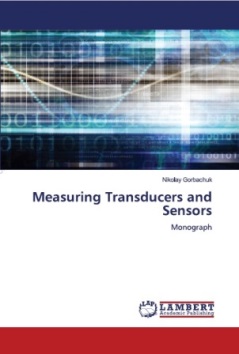Transducers, gauges, sensors - Information portal © 2011 - 2025 Use of material is possible by placing an active link
Photoconductivity
While in metals - conductivity is observed at different temperatures, conductivity of semiconductors in ordinary terms arises up only due to a thermomotion. However it is possible to create such terms which provide appearance of conductivity in a semiconductor and without the increase of his temperature. Because conductivity of semiconductor arises up only because of that electrons get in the area of conductivity, then it is enough to reveal to the electrons energy, necessary for kicking about them in a clearzone, that conductivity was. This energy in ordinary terms electrons get from participating in the thermomotion of other particles, but energy can also act from outside, in particular, for example, as a radiation.
As early as past century it was discovered that resistance of selenium stick sharply changes depending on her illumination. Careful researches showed that resistance of selenium diminished at illumination.
It was later succeeded to set that this property is possessed by not only selenium but also some other semiconductors. Appearance of квантомеханических presentations enabled to explain this phenomenon, getting the name of photoconductivity or internal photoeffect in science.
Physical nature of photoconductivity consists in the following. At some temperature in a black-out semiconductor some number of electrons of n is in a clearzone. These electrons stipulate ordinary conductivity of matter, otherwise called темновой. If after it a semiconductor will be exposed to illumination, then in a clearzone, besides already existing there before darkly electrons, the new number of n1 of light electrons and incurrence of electrons will appear in an area n + n1 Conductivity will become equal in this connection will grow and will become equal
σ = пеU + п1 еU1,
where the first element answers темновой conductivity, and second - to photoconductivity.
From the most general pictures of nature of semiconductors reason of appearance becomes quite clear in the clearzone of фотоэлектронов. Undoubtedly, that an unalloyed semiconductor has the filled area the supplier of both темновых and light electrons. Clearly, that both the electrons got in a clearzone only because got energy, necessary to them for overcoming of the restricted area
""breadthways" ΔE. Consequently, photoconductivity arose up due to that falling on the surface of semiconductor and eaten up by him photons gave a photo to the electrons all energy. Every photon carries energy of hν. If this energy on a size more energy of ΔЕ or, at least, equal to her, then an electron from the filled area will be able to pass to the area of conductivity. From here necessary investigation flows out : photoconductivity is possible then, when hν > ΔЕ. Thus, for every photo of sensible matter there is the border of photoconductivity, responding to the condition
hνo = ΔЕ.
If frequency of n of falling on a semiconductor radiation less than no, then photoconductivity does not arise up.
Only a radiation with frequency of ν > νο is able to create photoconductivity.
The border of photoeffect, i.e. size of no, depends on a semiconductor which a photoeffect is in, from that, unalloyed he or no.
Photoconductivity, or internal photoeffect, arises up far not in all semiconductors. Regardless of it the necessary condition of appearance of photoconductivity is absorption the matter of falling on him radiation. Only in this case there can in principle be a photoeffect.
It was set by the experiments of soviet physicists, that on the conduct of photo electrons differ nothing from thermal electrons up to a practically complete coincidence them подвижностей.
The careful study of internal photoeffect showed that the change of resistance in different matters arose up under the action of radiation of different spectral composition : at one matters it is observed then, when a matter is lighted up by ultraviolet rays, at other - at illumination visible or infra-red rays.
Exempt light electrons during the very short interval of time are in a clearzone. For this time they roam in межатомных intervals and at presence of difference of potentials between two points of semiconductor move mainly one-way, forming, thus, an electric current. Then a photo electrons pass to more low levels of admixtures or in the filled area. However at continuous illumination of semiconductor all new and new photos appear electrons, and for the same time some their number countermarches. A dynamic equilibrium is set as a result, i.e. the number of nascent photos of electrons becomes equal to the number of electrons, returning back.
In the free state of photo electrons there is extraordinarily small time (order a from 10^-3 to 10^-7 sec.). But in this short interval of time of life they are the valuable electrons of conductivity. Semiconductor matters considerably promote the conductivity not only under the action of radiation. Any other particle, getting in an atom and giving here to the electron all energy, in principle is able to transfer an electron in the free state. Indeed, numerous, repeatedly repeated experiments showed that conductivity arose up and in that case, when the surface of matter is bombarded by rapid electrons, alpha - by particles, protons, дейтонами and other particles. Clearly, that for this purpose energy of bombarding particle must be more energy of translation of electron is in the free state.
In semiconductors the concentration of electrons of conductivity considerably less than, than at metals at a room temperature, and the number of appearing under the action of light photos of electrons is relatively great. At corresponding illumination in some matters, as, for example, in a sulphureous cadmium (CdS), the number of photo of electrons can on four orders exceed a number it is dark electrons of conductivity. In other less photos sensible matters the number of photo of electrons even not at a too intensive radiation can arrive at 20-30% from the incurrence of electrons of conductivity. It property of some semiconductors does them by essential and necessary materials.
русский / english
Home >> Photo effects, light. Photoconductivity
Photoconductivity
Photoeffect of plug-forming layer
Solar battery
Selenium photocells
Selenium fotoresistance
Bolometrs
Photo effects, light
• Information about various converters and sensors of physical quantities, parameters of various physical processes is presented.
• Electrophysical properties and effects in various electrical materials.
• Theory, experimental results, practical application

See also:
CONVERTERS, GAUGES, SENSORS
Information, news, advertising


